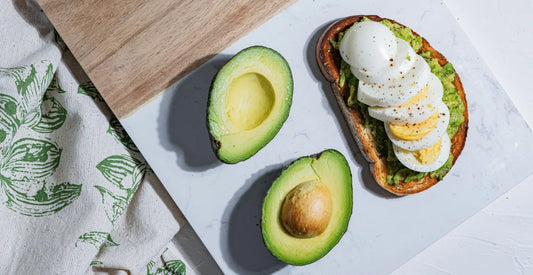Key takeaways:
- Seasonal eating for autumn wellness: Aligning with seasonal eating in the UK and choosing local autumn fruits and autumn vegetables like squash, apples, brassicas, and mushrooms supports lung health, immunity, and emotional balance as recommended by Traditional Chinese Medicine (TCM).
- Healthy autumn recipes and dinner ideas: Incorporating warming, moisture-rich dishes such as root vegetable stews, roasted squash, and fruit crumbles offers delicious autumn dinner ideas, aids digestion, and helps the body adapt to the cooler, drier climate.
- Traditional Chinese Medicine principles for seasonal eating: Following TCM guidance by eating pungent, warming foods and light-coloured seasonal produce helps maintain internal balance, nourish the lungs, and prepare the body for winter during autumn in the UK.
Autumn is a season of change – a time when the air turns crisp, the daylight wanes, and nature prepares for the quiet of winter.
According to Traditional Chinese Medicine (TCM), autumn corresponds to the Metal element and the Lung organ system, making it a critical period to nourish the body and strengthen immunity (1). Seasonal eating – a cornerstone of TCM – encourages us to align our diets with nature’s rhythms, promoting internal balance and resilience (5). By consuming foods that support lung health and counteract the dryness of autumn, we can prevent imbalances, enhance energy, and prepare our bodies for the colder months ahead (2).
In this article, we’ll explore the principles of Traditional Chinese Medicine seasonal eating in autumn, examine the benefits from both Eastern and Western perspectives, highlight seasonal produce available in the UK, and provide practical recipes and preparation methods to help you thrive this season.

What is Traditional Chinese Medicine?
Traditional Chinese Medicine (TCM) is a holistic medical system that has been practised for thousands of years across China and East Asia. Unlike Western medicine, which often focuses on treating symptoms, TCM emphasises maintaining harmony within the body and between the body and its environment (5).
Key concepts in TCM
- Qi (Chi): The vital life force or energy that flows through the body.
- Yin and Yang: Complementary forces that must remain balanced for optimal health.
- Meridians: Pathways through which Qi travels to nourish organ systems.
Common practices in TCM
- Herbal medicine: Using plants, minerals, and select animal products to restore balance.
- Acupuncture: Stimulating specific points with fine needles to regulate Qi flow.
- Cupping therapy: Applying suction cups to improve circulation.
- Moxibustion: Burning medicinal herbs near the skin to warm energy channels.
- Movement & breathing exercises: Practices such as Tuina massage, Qigong, and Tai Chi harmonise energy and promote wellbeing.
Traditional Chinese Medicine and seasonal eating
In Healing with Whole Foods, Paul Pitchford emphasises the importance of aligning our diet with seasonal rhythms (5). Each season corresponds to specific organs and elements in TCM, and eating in harmony with these cycles supports overall health and prevents imbalance.
Seasonal correspondences in Traditional Chinese Medicine
- 🌱 Spring (Liver, Wood element): Renewal, growth, upward energy. Eat fresh greens, sprouts, and sour foods; avoid greasy dishes.
- ☀️ Summer (Heart, Fire element): Maximum Yang, warmth, activity. Eat cooling foods like melons, cucumbers, leafy greens; avoid fried or overly spicy foods.
- 🌾 Late Summer (Spleen, Earth element): Transition and grounding. Eat sweet foods like corn, carrots, squash, and grains; avoid excessive cold or raw foods.
- 🍂 Autumn (Lungs, Metal element): Dryness, contraction, letting go. Eat moistening foods like pears, apples, honey, sesame, and white radish; pungent flavours like garlic and ginger help open the lungs; avoid overly dry foods.
- ❄️ Winter (Kidneys, Water element): Stillness and conservation. Eat warming stews, root vegetables, beans, and nuts; avoid raw or cold foods.

Why eat seasonally in autumn?
Western perspective
- Health benefits:
- Seasonal fruits and vegetables are at peak ripeness, maximising vitamins, minerals, and antioxidants.
- Produce tastes fresher and sweeter when in season.
- The body naturally adapts its nutrient and moisture needs as the weather changes.
- Economic benefits:
- Local, seasonal produce is more abundant and often cheaper.
- Supports local farmers and strengthens community food systems.
- Environmental benefits:
- Shorter transport distances reduce carbon footprints.
- Less reliance on chemical-intensive or energy-heavy greenhouse farming.
- Encourages biodiversity through crop rotation and varied farming practices.
- Lifestyle benefits:
- Promotes variety in the diet.
- Fosters a deeper connection to natural cycles and mindful eating (2).
Traditional Chinese Medicine perspective
- Nourish the lungs:
- The lungs control breathing, skin health, and immunity. Dryness can cause coughs, dry throat, and rough skin.
- Moistening foods like pears, white radish, lily bulb, honey, and sesame help protect Lung Yin.
- Counteract dryness:
- Autumn can deplete body fluids; hydrating foods such as apples, pumpkins, tremella mushrooms, and soy products maintain balance.
- Strengthen Wei Qi (defensive Qi):
- As cold and flu season begins, warming soups, root vegetables, grains, and spices strengthen immunity.
- Support emotional balance:
- Autumn is associated with grief in TCM; nourishing and grounding foods stabilise mood and prevent Lung Qi stagnation.
- Prepare for winter:
- Heavier seasonal foods like squash, sweet potatoes, and chestnuts build reserves and strengthen the kidneys for colder months (5, 6).
Autumn seasonal eating from a Traditional Chinese Medicine perspective
Nourishing your body for autumn resilience
In Traditional Chinese Medicine (TCM), this season is associated with the Metal element, which governs the lungs and large intestine. These organs play a vital role in immunity, energy distribution, and emotional balance, making it especially important to nourish them during this transitional period.
The cooler, drier climate of autumn can deplete Lung Yin, leading to dryness, coughs, and lowered resistance to seasonal colds. To maintain resilience, TCM emphasises warm, moistening, and easily digestible foods that harmonise with the season’s energy.
Below are some key focus areas and food recommendations that support the body during autumn.
Lung health & moisture
The lungs are highly sensitive to dryness, which is why moistening foods become so important at this time of year. Pears and apples, especially when lightly cooked with honey, are classic remedies for soothing a dry throat and calming coughs. White fungus (Tremella) and lily bulbs are traditional ingredients often used in Chinese soups and desserts to nourish Lung Yin and restore moisture. Incorporating these foods regularly can help ease seasonal dryness and support clear, healthy breathing.
Warm, cooked foods
TCM places great importance on eating in harmony with the seasons. As the weather cools, raw foods such as salads can be harder on digestion. Instead, warming preparations like soups, stews, and porridges gently support the spleen and stomach while providing sustained energy. Root vegetables – such as sweet potatoes, squash, carrots, and parsnips - not only offer grounding nourishment but also help balance autumn dryness. Slow cooking methods allow the digestive system to conserve energy while drawing out the natural sweetness of seasonal produce.
Immune support & Qi
Autumn is also a time when our body’s protective Qi (Wei Qi) must be fortified to guard against seasonal illnesses. Foods with pungent, warming qualities – like garlic, ginger, onions, and horseradish - are excellent allies. They stimulate circulation, open the respiratory passages, and act as natural immune boosters. Adding a dash of warming spices such as cinnamon or star anise to meals not only enhances flavour but also strengthens the body’s defences.
Elemental balance
In TCM, seasonal eating is not just about individual ingredients but about maintaining balance. The Metal element, linked with the lungs and large intestine, benefits from light-coloured foods such as radish, lotus root, white beans, cauliflower, almonds, and rice. These foods are thought to purify, regulate moisture, and harmonise Yin and Yang. Regularly including them in meals helps ensure smooth digestion and balanced energy flow during autumn’s fluctuating weather.
Gratifying beverages
As tempting as cold drinks may be, autumn calls for warm and soothing beverages. Herbal teas, lightly brewed green tea, and nourishing soups infused with honey or warming herbs can help keep the lungs moist, ease digestion, and ward off chills. A simple ginger-honey tea, for example, is both comforting and effective in supporting respiratory health while adding gentle warmth to the body.

Autumn fruits and vegetables in the UK and their Traditional Chinese Medicine benefits
| Food group | Examples | Traditional Chinese Medicine (TCM) properties & seasonal eating benefits |
|---|---|---|
| Root vegetables | Carrots, parsnips, sweet potatoes, turnips | Grounding and warming; support digestion and stable energy. |
| Apples & pears | Locally grown UK varieties | Slightly sour and moistening; nourish Lung Yin and ease dryness. |
| Brassicas | Broccoli, cauliflower, Brussels sprouts | Detoxifying; supports lung & large intestine function. |
| Mushrooms | Shiitake, white mushrooms | Strengthen Qi; enhance immunity; support lung health. |
| Squash & pumpkins | Butternut squash, pumpkin, marrow | Rich and warming; tonify spleen & stomach; provide nourishment and comfort. |
🍂 Clinical Nutritionist Vicky McGregor’s favourite Traditional Chinese Medicine inspired healthy autumn recipes
1. Root vegetable stew
This hearty stew blends autumn’s best root vegetables with fragrant aromatics. It’s warming, deeply nourishing, and perfect for supporting spleen and stomach health in TCM.
Ingredients
- Carrots, parsnips, sweet potatoes, turnips (choose a mix of 4–5 types, cubed)
- Onion, garlic, ginger (finely chopped)
- Vegetable stock (enough to cover veggies)
- Optional: leeks or potatoes for added texture
- Seasoning: herbs like marjoram, thyme, salt, pepper
Method
- Sweat the onion, garlic, and ginger in a splash of oil until fragrant.
- Add the chopped root vegetables and optional extras like leeks or potatoes.
- Pour in stock to cover, then simmer gently for about 40 minutes until all veggies are tender.
- Stir in herbs, adjust seasoning, and serve with crusty bread or a leafy salad.
TCM note: Warming and grounding, this stew supports the spleen and stomach and helps tether energy during autumn transitions.

2. Roasted squash & pumpkin
Ingredients
- Butternut squash and/or pumpkin, peeled, seeded, and cubed
- Olive oil
- Warming spices: cinnamon, nutmeg (plus sage or maple syrup if desired)
Method
- Toss squash or pumpkin cubes with olive oil, cinnamon, nutmeg, salt, and pepper.
- Spread evenly on a baking tray.
- Roast at 200–220 °C for 25–35 minutes until golden and tender, turning halfway.
TCM note: The naturally sweet and warming nature of squash nourishes the spleen, supports digestion, and balances the cooler, drier energy of autumn.

3. Apple & pear crumble
Ingredients
- Apples and pears (sliced)
- Oats, nuts, butter, honey or brown sugar, cinnamon
- Optional: flour, citrus zest, nutmeg
Method
- Preheat oven to 180 °C.
- Arrange apples and pears in a baking dish with cinnamon (and optional zest).
- In another bowl, mix oats, nuts, butter, and sweetener until crumbly.
- Sprinkle topping over fruit and bake for 25–50 minutes until golden and bubbling.
TCM note: This dessert nourishes Lung Yin, eases digestion, and provides gentle sweetness for the spleen.

4. Mushroom & brassica stir-fry
Ingredients
- Shiitake or white mushrooms
- Broccoli, cauliflower (or other brassicas)
- Garlic, ginger, soy sauce (or tamari)
- Optional: sesame oil for sauce
Method
- Lightly steam broccoli until just tender, then set aside.
- Stir-fry mushrooms until golden, then add garlic and ginger.
- Return broccoli to the pan, add soy-based sauce, and cook briefly until glazed.
- Serve hot over rice or noodles for a quick, nourishing meal.
TCM note: Strengthens immunity, supports Lung Qi, and aids natural detoxification.

Final thoughts on autumn seasonal eating and Traditional Chinese Medicine
Autumn aligns with the Metal element and Lung system in Traditional Chinese Medicine, making it vital to nourish the lungs, maintain moisture and support immunity. One of the simplest ways to do this is through seasonal eating, which not only harmonises the body with natural cycles, but also brings health, economic, environmental and lifestyle benefits.
Key Traditional Chinese Medicine principles for autumn include:
- Moistening foods (pears, apples, lily bulbs, white fungus) protect Lung Yin and counter dryness.
- Warming, cooked foods (soups, stews, root vegetables) aid digestion and provide grounding energy.
- Pungent, warming ingredients (garlic, ginger, onions, spices) strengthen defensive Qi and immunity.
- Light-coloured foods (radish, cauliflower, white beans, rice) support elemental balance and smooth energy flow.
Autumn fruits and other seasonal vegetables in the UK such as apples, pears, root vegetables, squash, brassicas, and mushrooms offer both nutritional and holistic benefits. They can be enjoyed in simple yet comforting TCM-inspired autumn recipes, such as root vegetable stew, roasted squash, apple & pear crumble, and mushroom & brassica stir-fry integrate seasonal, lung-supportive, and immunity-boosting foods.
Overall, autumnal seasonal eating according to TCM helps maintain internal balance, prepare the body for winter, and support both physical and emotional wellbeing.
Need further support? Book a Wellbeing Consultation with a Clinical Nutritionist
For those seeking an integrative approach to health, a CBD & Wellbeing Deep Dive Consultation with Provacan offers personalised guidance. Led by a qualified Naturopathic Nutritional Therapist, this 50-minute session provides strategies to integrate CBD, improve sleep, manage stress, and enhance vitality. Clients receive a customised 8-week action plan to support their health and wellbeing goal.
Learn more and schedule your CBD & Wellbeing Deep Dive Consultation now.
Get social with us
Autumn is here – the perfect season for hearty, nourishing recipes. Do you have a favourite dish you love to make this time of year? We’d love to see it! Share your creations and tag us so we can celebrate the new season together.
Instagram
👉 Follow Vicky: @vickythenutritionist
👉 Follow Provacan Health: @provacan_health
Facebook
👉 Follow Vicky: Vicky the Nutritionist
👉 Follow Provacan Health: Provacan Health
Sources
- Alban Acupuncture. Five traditional Chinese medicine foods to prepare for fall. https://albanacupuncture.com/five-traditional-chinese-medicine-foods-to-prepare-for-fall/
- NewellnessMPLS. Autumn season and traditional Chinese medicine. https://newellnessmpls.com/autumn-season-and-traditional-chinese-medicine/
- NCIM UK. Moving into autumn with traditional Chinese medicine. https://ncim.org.uk/moving-into-autumn-with-traditional-chinese-medicine/
- Shaolin Temple. Autumn eating according to traditional Chinese medicine. https://www.shaolintemple.com/autumn-eating-according-to-traditional-chinese-medicine/
- Pitchford, P. (2002). Healing with whole foods: Asian traditions and modern nutrition (3rd ed., rev., updated and expanded). Berkeley, CA: North Atlantic Books.
- NCIM. Moving into autumn with TCM. https://ncim.org.uk/moving-into-autumn-with-tcm/
- Hodge, Y. Autumn: A time to support our lungs. https://example.com/autumn-support-lungs/
- Acupuncture Huddersfield. Autumn foods TCM. https://acupuncturehuddersfield.com/autumn-foods-tcm/
- Golden Door STL. Autumn, the season of letting go. https://goldendoorstl.com/autumn-the-season-of-letting-go/
- Easy Real Food. Chunky root vegetable stew. https://easyrealfood.com/chunky-root-vegetable-stew/
- Sip and Feast. How to roast butternut squash with brown sugar. https://www.sipandfeast.com/how-to-roast-butternut-squash-with-brown-sugar/
- Mama Gourmand. Roasted pumpkin spice butternut squash. https://www.mamagourmand.com/roasted-pumpkin-spice-butternut-squash/
- AllRecipes. Apple and pear crumble. https://www.allrecipes.com/recipe/229252/apple-and-pear-crumble/
- Food52. Apple-pear crispy crumble. https://food52.com/recipes/2084-apple-pear-crispy-crumble
- Omnivore’s Cookbook. Broccoli and mushroom stir fry. https://omnivorescookbook.com/broccoli-and-mushroom-stir-fry/
- Wholesome Made Easy. Broccoli mushroom stir fry. https://wholesomemadeeasy.com/broccoli-mushroom-stir-fry/






















